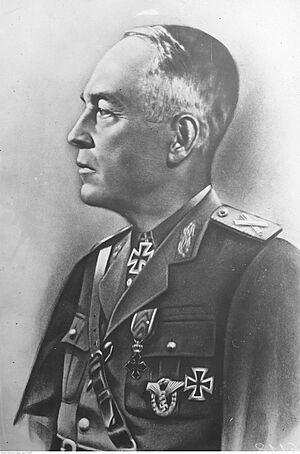Ion Antonescu facts for kids
Quick facts for kids
Marshal
Ion Antonescu
|
|
|---|---|

Official portrait, 1942
|
|
| Conducător of Romania | |
| In office 6 September 1940 – 23 August 1944 |
|
| Preceded by | Position established |
| Succeeded by | Position abolished |
| 43rd Prime Minister of Romania | |
| In office 5 September 1940 – 23 August 1944 |
|
| Monarch | Carol II Michael I |
| Deputy | Horia Sima (1940–1941) Mihai Antonescu (1941–1944) |
| Preceded by | Ion Gigurtu |
| Succeeded by | Constantin Sănătescu |
Ion Antonescu was a Romanian military leader and marshal. He served as the Prime Minister and Conducător (meaning "leader") of Romania during most of World War II. His decisions during this time led to very sad events for many people. After the war, he was put on trial for his actions and was executed in 1946.
Contents
Early Life and Military Start
Ion Antonescu was born in Pitești, Romania, in 1882. His family had a history of military service. His father was an army officer. He wanted Ion to follow in his footsteps. So, Ion went to a special school to become an officer.
Ion Antonescu became a career officer in the Romanian Army. He first became known during the 1907 Romanian peasants' revolt. He also played a role in World War I.
Rise to Power
Antonescu became interested in far-right and fascist ideas. These are political beliefs that often involve strong national pride and a powerful leader. He worked as a military expert in France. Later, he became the head of the Romanian army's main office.
He briefly served as the Minister of Defense. This was in the late 1930s. His political views caused problems with King Carol II. This led to Antonescu being held for a short time.
In 1940, Antonescu became very important in Romanian politics. He formed a government called the National Legionary State. He worked with a group called the Iron Guard.
Leadership During World War II
Romania joined forces with Nazi Germany during World War II. This alliance was part of the Axis powers. Antonescu then removed the Iron Guard from power. This happened during a conflict in 1941.
Besides being Prime Minister, he also managed foreign affairs and defense. Romania joined Germany in Operation Barbarossa. This was the invasion of the Soviet Union. Romania took back areas like Bessarabia and Northern Bukovina. Soon after, Antonescu became a Marshal of Romania.
Impact of His Decisions
Antonescu's leadership led to the deaths of many people. Most of them were Jewish people from Romania and Ukraine. Roma people (sometimes called Romani) also suffered greatly. His government was involved in the Holocaust in Romania. This included terrible events like the 1941 Odessa massacre. People were also forced to move to Transnistria.
End of His Rule
In 1944, Allied forces started bombing Romania. Romanian soldiers also suffered many losses on the Eastern Front. Antonescu tried to make peace with the Allies. However, these talks did not lead to an agreement.
On August 23, 1944, King Michael I led a coup d'état. This means he took power from Antonescu. Antonescu was arrested. After the war, he was found guilty of war crimes. He was executed in June 1946.
Images for kids
See also
 In Spanish: Ion Antonescu para niños
In Spanish: Ion Antonescu para niños


